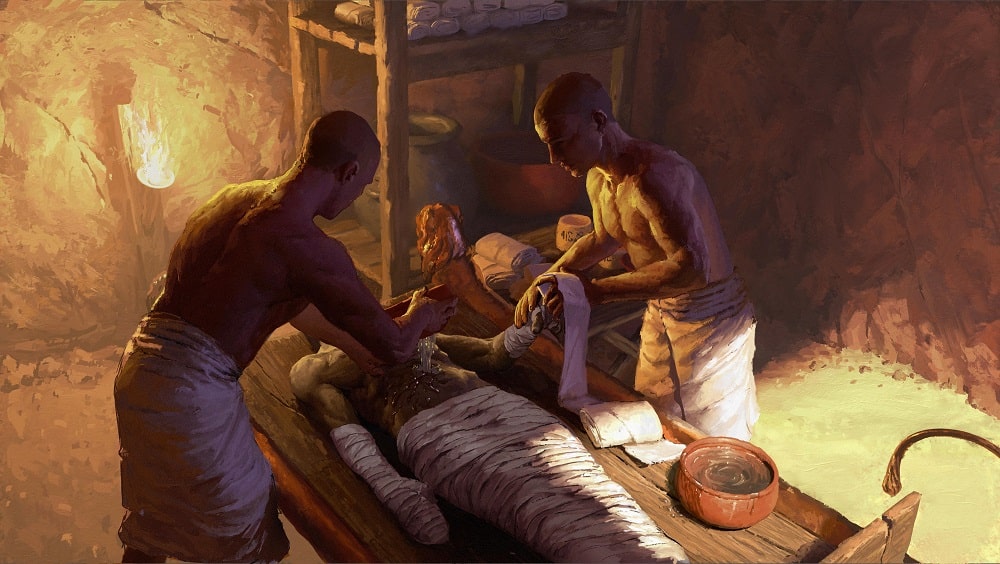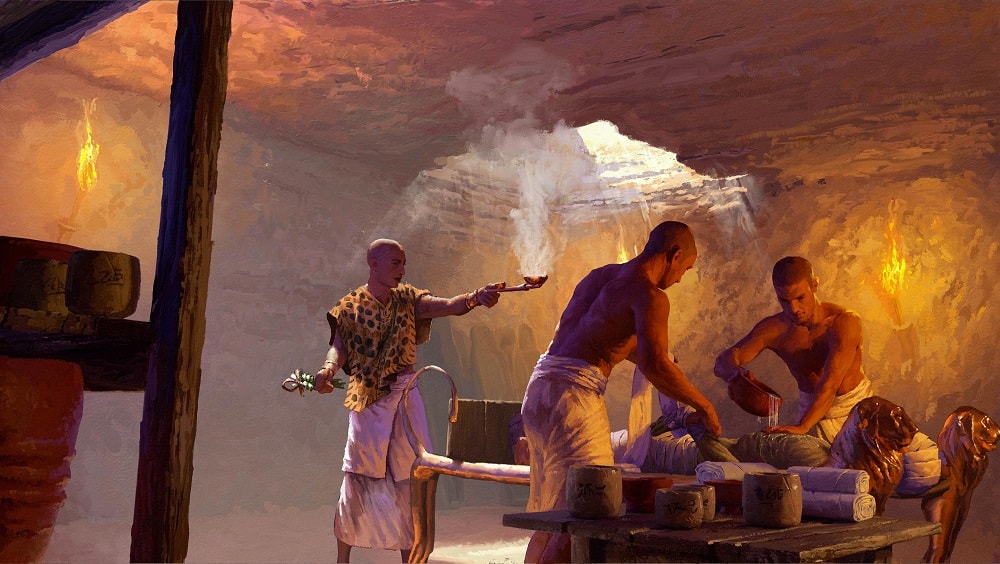
Ancient Egypt has left us an extraordinary lasting legacy. Its art and architecture have been widely copied, and its antiquities can be found in museums in the far corners of the world.
The first thing that probably comes to mind when you hear ‘ancient Egypt’ is its gigantic pyramids. But equally long-lasting are its many mummies, including those of great pharaohs embalmed many thousands of years ago. Yet although we’ve come a long way in understanding how the ancients prepared bodies for mummification, many of the fine details have escaped us.
Now, a new study has made exciting new revelations about this ancient practice of preserving the dead. A German-Egyptian team of researchers analyzed chemical residues from vessels unearthed at an embalming workshop in Saqqara, close to the pyramid of Unas in Lower Egypt, where ancient Egyptians used to embalm the corpses of the elite more than 2,500 years ago, during the 26th Dynasty of Egypt (664-525 B.C.).
In the process, the chemical analysis of the 31 ceramic vessels revealed the nature of many embalming ingredients that were previously cryptic in recipes from surviving ancient papyrus texts. By identifying these substances, the researchers not only enriched our understanding of the complex mummification process but also inferred a rich cultural story, deciphering the meaning of some terms used in ancient texts and demonstrating the role that mummification had in fostering long-distance trade from as far as South-East Asia.
“For me, the most fascinating result was the chemical knowledge of the ancient embalmers without having any idea about microbiology – they just had centuries of experience and observation of which substances contribute to better preservation of the human body,” Philipp Stockhammer, Professor of archaeology at Ludwig-Maximilians-University and co-author of the new study, told ZME Science.
The nuts and bolts of ancient Egyptian mummification

Mummification involves removing moisture from the body and applying certain chemicals and natural preservatives to desiccate the flesh and organs. Many ancient cultures employed this time-honored tradition, imbued with deep religious significance, including the Chinese and many pre-Columbian societies in South America. But it was in ancient Egypt that mummification reached its pinnacle, a sophistication that mirrored the ancient Egyptians’ obsession with the afterlife.
The ancient Egyptians strongly believed that when a person died, their spiritual essence would survive and immediately embark on a journey where they would encounter various divine and demonic entities. Ultimately, the traveling soul would meet Osiris, the god of the dead, who would judge if the wandering spirit is worthy of joining the gods in an eternal paradise.
But for this spiritual journey to be successful, the physical body had to remain intact for as long as possible, much to the distress of the common folk who were too poor to afford this very expensive embalming.
“It is clear that only a small (rich) part of the Egyptian elite was mummified. The poor farmers were just buried in pits in the desert. Moreover, we know from ancient texts that depending on your financial possibilities, you could invest in different “quality packages” for the mummification/embalming,” Stockhammer said.
Since mummification was literally a matter of life after death, great care and much deliberation were put into this process, which was refined over the centuries to perfection — despite the lack of formal knowledge of what we would call today microbiology. Indeed, the ancient Egyptians had no idea that microbes even existed, but through much trial and error, they found the right mixtures and procedures that preserved thousands of mummies even to this very day.
Unfortunately, the exact steps in this mortuary practice are largely a mystery. We know more about the rituals involved in mummification rather than the actual process itself. The little we know from the particularities of the practice comes from a few surviving texts, and largely from non-Egyptian sources to boot, such as The Histories by Herodotus, which describes three levels of mummification.
However, the researchers of the new study came across the finding of a lifetime. Traveling to Egypt to the Saqqara workshop, they were amazed to find numerous vessels employed by skilled craftsmen to mummify the dead. The remarkable vessels still contained evidence of their past contents, no doubt ingredients used in embalming.
That’s not all. These vessels were also labeled with their contents and even had instructions for use, such as “substance for the head” or “for making beautiful skin”.

The researchers analyzed the chemical residues in the vessels and then compared the molecular remains to the actual ingredients listed on them.
This is how they came to learn that the substance labeled as antiu, previously translated as myrrh or frankincense, is actually a mixture of many different ingredients. The blend that the craftsmen in Saqqara called antiu contained cedar oil, juniper, cypress oil, and animal fats.
“For the first time, we know what terms like “antiu” mean (at least in the early 1st mill BC in our workshop), as Egyptologists could only speculate about its meaning for the last almost 200 years. This will enable/force a new reading of many Egyptian texts,” Stockhammer said.
The pistachio resin and castor oil were used only to preserve the head, while other mixtures were used to wash the body or soften the skin. The pistachio resin, cedar oil, and bitumen were probably sourced locally in the Levant. Other identified ingredients, such as dammar gum and elemi resin, could only come from tropical Africa and Southeast Asia.
Without explicitly mentioning this, the ancient residues and labels on the ceramic vessels thereby paint a remarkable picture of extensive and sophisticated trade networks that connected Egypt with tropical Africa and Southeast Asia. These trade networks were already cemented nearly 3,000 years ago.
“Egyptian embalming was probably a driver forward towards early globalization and long-distance trade. Now, we have to rethink the intensity and complexity of early globalization and rethink our dominating notion that global connectedness is a phenomenon limited to modernity,” the German archaeologist said.
All of this is quite consequential for archaeology and the study is bound to cause waves in Egyptology for many years to come — and it’s all thanks to a couple of dozen seemingly unsuspecting old pieces of pottery. But the authors would also like to remind us all that such invaluable work is not always without sacrifice.
“By far the biggest challenge was the premature death of the excavator of the embalmers’ workshop, Ramadan Hussein, in March 2022. Maxime, Ramadan and I had already finished large parts of the manuscript and it was very much Ramadan’s last wish to see the fruits of his years of research getting published. We are happy that this has now become possible in such a wonderful way,” Stockhammer said.
The findings appeared in the journal Nature.


